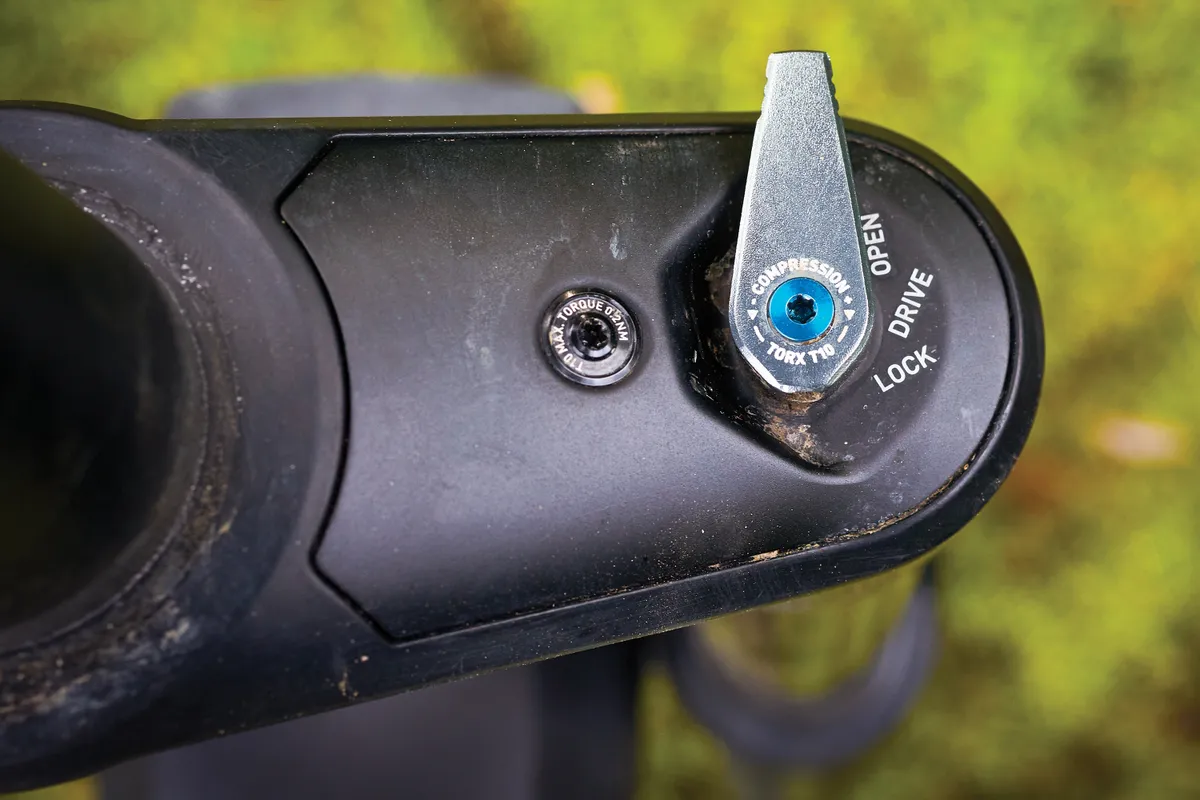DT Swiss has been making forks for years, but so far nothing like this. The F 535 is designed to compete head-on with the big manufacturers such as Fox and RockShox for a slice of the trail/enduro fork market. In fact, it’s the only fork I’ve tested so far that comes close to matching the big two brands.
Available with 130–160mm of travel, it’s aimed more at the trail market than many of the enduro forks I’ve tested. However, at 2,160g it is heavy even by enduro fork standards.
- How much suspension travel do I need on my mountain bike?
- How to set up your mountain bike suspension
The fork looks sleek with its covered-up crown, but you’ll need the T10 Torx tool housed in the axle to adjust air pressure, as well as compression or rebound damping.
As a frequent fettler, I found this frustrating, and I managed to lose the tool at one point. The cable clamp and included mudguard are fiddly to install too and the latter offers little mud protection.
It’s what’s inside the fork that counts, though. Unusually, the damper features a position-sensitive valve, which makes the compression damping gradually firmer the further into the travel you get. This makes the fork suppler in the beginning stroke, while building damping support as you get deeper into the travel.
In the other leg, the spring features a self-equalising air spring which is tuneable with volume spacers (like you’d get in most Fox or RockShox forks) with an additional little coil spring on the end.
This coil spring allows the fork to move before the bump force becomes high enough to overcome friction in the air spring. Once the coil spring has compressed sufficiently, the air spring friction is overcome and the air spring deals with the rest of the travel. According to DT Swiss, the mini coil spring allows the fork to change direction and start moving sooner, thereby increasing comfort and traction.
It’s worth pointing out that if you wanted to change the travel in your F 535, you’d need to swap the damper as well as the spring, because the damper is travel-specific.
- This fork was tested as part of a group test including ten of the best enduro forks. All forks were tested back-to-back on the same tracks, keeping all other variables as consistent as possible to ensure my findings are as reliable and accurate as they can be.
DT Swiss F 535 ONE fork setup

DT’s online set-up guide makes tuning straightforward. For my weight (86kg) it recommended 92psi for “performance -orientated” riding, resulting in 22 percent sag.
After experimenting either way, I found this was spot on. It also recommended keeping the compression damping fully open, which I felt no benefit to changing. However, I did have to open the rebound from the base setting to sustain suppleness through high-frequency bumps.
DT Swiss F 535 ONE fork performance
On steep terrain with rocky steps and holes, you can really feel the damping hold you up in the travel. There’s plenty of low-speed support and a calm, composed feel through slow technical sections. Yet it hoovers up small stones and wrist-sized roots with fantastic comfort, minimal feedback and loads of grip thanks to a softly-damped and softly-sprung beginning of the stroke.
This could be due to the clever damper or spring, but I suspect the F 535’s flexy chassis may improve comfort and traction too in small-bump situations.
But on fast tracks with big bumps, the flex becomes problematic. Even with the compression fully open, there’s a fair bit of jarring feedback when slamming into bigger bumps.
When loaded up hard into pitted turns, it becomes slightly wayward and unpredictable; it occasionally loses traction and is deflected wide where the best forks tracked more authoritatively. I tried dropping air pressure to ease the occasional harshness, but this caused the fork to lack support and bottom-out hard.
Ultimately there’s no way to get around this lack of stiffness when riding hard through burly terrain; it causes the fork to deflect and bind up, which makes it feel harsh and unpredictable.
Having said that, shorter travel and 27.5in models will be less affected by flex. It’s only when ridden aggressively over rough, hardpack terrain that the flex becomes problematic, and in some situations, it may even be a benefit.
How does it compare to its main rivals?
Over small, high-frequency bumps, the F 535 is the comfiest I’ve tested, and over milder terrain it’s one of the very best.
But when faced with bigger bumps, there’s noticeably more feedback and less predictability than the best enduro forks from Fox and RockShox, and that includes the more wallet-friendly Marzocchi Z1 and RockShox Yari.
It’s among the best of the rest though, especially for lighter riders or those who value comfort and grip most.
DT Swiss F 535 ONE fork options
Travel
- 27.5in: 130, 140, 150, 160mm
- 29in: 130, 140, 150, 160mm (tested)
Offset
- 27.5in: 44mm
- 29in: 51mm
This video shows how I tested the forks and how they compare.
Product
| Brand | Dt_swiss |
| Price | £925.00, $1551.00 |
| Weight | 2160g |
Features
| Wheel size | 29in_700c |
| Offset | 51.0000 |
| Offset | MILLIMETER |
| Travel | 169.0000 |
| Travel | MILLIMETER |
| Features | Crown to axle length: 565mm |
